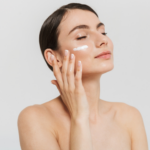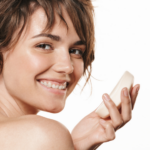The popular belief is the skin is a good reflection of a person’s health. Whether that’s backed by hard science or not, it pays to eat right for healthier and more beautiful skin. So how can you feed your skin from the inside out?
You can feed your skin from the inside out with a well-balanced diet. Your skin will benefit from the same nutrient-dense foods you eat to keep your body healthy. Several studies have found that specific foods, nutrients, and eating patterns have a positive effect on various skin issues.
If you’re going to change your diet only for your skin’s sake, it is a good idea to speak to a dermatologist first. Read on to learn more about how you can feed your skin from the inside out!
Feed Your Skin from the Inside Out
Depending on your age, it takes an average of 28 to 45 days for your skin to renew itself. And, it’s believed that certain micronutrients (vitamins and minerals) and macronutrients (proteins, fats, and carbohydrates, among others) from food play a role in this process.
However, many dermatologists argue that there’s no hard science explaining the connection between food and the skin’s appearance or health. That was before. Recent research studies suggest that a person’s food choices and eating patterns can prevent or influence the outcome of skin disease, such as acne and psoriasis (a skin condition that causes raised, red, scaly patches of skin).
For instance, a diet rich in refined sugar could cause acne and speed up skin aging. Consuming sugary foods or drinks encourages cross-linking of the skin’s collagen fibers, which happens when a protein connects to another protein, lipid (sometimes used as another word for fats), or sugar. [1] This, in turn, leads to premature aging of the skin.
In one study (February 2001) published in the Journal of the American College of Nutrition, researchers found out that among the four ethnic groups included in the study, the group composed of Swedish elderly people (ages 70 and older) had the least skin wrinkling in areas exposed to the sun.
Based on data using major food groups, test subjects who had less wrinkled skin consumed more legumes, monosaturated fat (a dietary fat that’s liquid at room temperature), olive oil, and vegetables while consuming less butter, dairy products or milk, and sugar.
So we know that certain types of food can positively or negatively impact your skin; what should you eat to improve your skin’s health and appearance?
Below, you’ll find some of the vitamins, minerals, and nutrients that are known to nourish the skin and help with certain skin diseases.
The below video gives some great tips to healing your skin from the inside out:
9 Nutrients That Promote Beautiful and Healthy Skin
1. Vitamin C (Ascorbic Acid)
Vitamin C is a popular ingredient in many oral and skin care products for many great reasons. It’s well-known for its ability to promote collagen production and to keep the skin firm and plump.
It’s a potent antioxidant, so it usually counteracts the damage done by free radicals. By “stealing” the electron from the atoms (smallest components of an element) in your skin, they can destroy your skin’s DNA and proteins, causing it to age prematurely.
Since your body doesn’t make or store vitamin C, you need to get it from the foods you eat daily. Some of the highest vitamin C food sources are broccoli, guavas, peppers, sweet potatoes, spinach, tomatoes, and green, leafy vegetables.
2. Lutein and Zeaxanthin
Apparently, lutein and zeaxanthin are not only great for preventing and improving vision problems. It was only recently that their skin benefits had been discovered.
Like vitamin C, these two act as antioxidants. They protect your skin from premature aging (caused by free radicals) and ease ultraviolet B-induced inflammation.
A small study published in the Clinical, Cosmetic and Investigational Dermatology has shown that giving 2 mg of zeaxanthin and 10 mg of lutein to test subjects with mild to moderate dry skin significantly improved the color of their skin (if compared to the control test subjects).
Broccoli, kale, spinach, parsley, and peas are some of the richest sources of lutein and zeaxanthin. Fruits, such as kiwi, grapes, oranges, and peaches, also contain these antioxidants.
3. Curcumin
Curcumin is a major compound in turmeric, an Indian spice. Because of its antioxidant properties, it could help with medical conditions that make your skin red and itchy, such as eczema and rosacea.
It’s also a possible alternative treatment for acne. One clinical study has shown that it could prevent the growth of the acne bacterium called the Propionibacterium acnes. [4]
Turmeric and curcumin also have the potential to slow down aging. This is mainly due to its strong anti-inflammatory and antioxidant activities, which prevent the production of free radicals. Thus, they might be able to control aging by protecting your skin and internal organs from damage.
4. Choline
Your liver can make choline. However, it’s often not enough to meet your needs. That’s why you should get it from your diet.
Choline is a common food nutrient. Some of the best food sources of choline are eggs (or egg-based meals), peanuts, liver, pasta, beets, spinach, shellfish, fish, dairy products, potatoes, and wheat.
This nutrient seems to play an important role in promoting good memory, muscle control, and other important brain functions. Along with other compounds, such as essential fatty acids, it can keep your skin hydrated and well-protected from the harmful effects of toxins and free radicals.
The below video gives some good supplement recommendations for helping to clear your skin. I always recommend getting your vitamins and nutrients from food, but supplements are a convenient way to add on to a healthy diet:
5. Vitamin A (Retinoid)
Like lutein and zeaxanthin, the fat-soluble vitamin A (retinoid) is known for promoting good eyesight and preventing night blindness and age-related vision problems. Dermatologists often recommend the topical form of this vitamin for acne and wrinkles.
It helps fight skin aging and promote healthy, flawless skin by stimulating the production of new, plump skin cells and get rid of the old ones.
Beef liver, broccoli, sweet potato, carrots, fortified skim milk, fortified cereals, eggs, dark green, leafy vegetables, and orange and yellow fruits are just some of the foods that are rich in vitamin A.
6. Vitamin B3 (Niacinamide)
Niacinamide, the common form of vitamin B3, prevents dry and tight skin by reducing water loss and maintaining moisture balance. It boosts the production of keratin, which makes up the outer layer of the skin that, if deficient, could lead to sagging and wrinkling skin. It also stops the transfer of the color (pigment) into your skin cells to lighten dark spots.
Some of the niacin-rich foods you could add to your diet are liver, turkey, tuna, chicken breast, ground beef, salmon, tomatoes, lentils, peas, avocados, mangoes, guavas, bananas, and passion fruit.
7. Vitamin E
Vitamin E is another powerful antioxidant that keeps your immune system strong and helps your body use vitamin K. Your skin needs this because it protects it from the harmful effects of ultraviolet (UV) rays and free radicals. It’s also an anti-inflammatory agent in the skin, so it can reduce all signs of inflamed skin: swelling, thickness, redness, and itching.
Some believe that creams, ointments, and oils containing vitamin E could help heal and fade scars. However, this is mostly anecdotal and still requires further research.
Vitamin E is found in certain vegetable oils (e.g., corn, sunflower, and wheat germ oils), fruits (e.g., avocado, mango, and kiwi), sunflower seeds, nuts (e.g., almonds, hazelnuts, and Brazil nuts), goose meat, abalone, and Atlantic salmon.
8. Vitamin K
A deficiency of vitamin K could lead to severe bleeding. Luckily, it rarely happens in adults. Because of its ability to support healthy blood vessels and blood clotting, eating enough vitamin K-rich foods may help get rid of puffy eyes and dark circles around the eyes.
Vitamin K can also prevent calcium from collecting in your large blood vessels (arteries). When skin blood vessels become inelastic, it could lead to premature aging and disease.
Examples of foods that are rich in vitamin K are broccoli, Brussels sprouts, collard greens, kale, green beans, kiwi, mustard greens, pork chop, prunes, spinach, and nattō (a soybean-based Japanese food).
9. Selenium
Selenium is naturally present in many foods. In fact, Brazil nuts are one of the best sources of this essential mineral. Other good food sources of selenium are beans, brown rice, liver, meat, mushrooms, oats, oysters, and tuna.
Why is selenium good for your skin?
Selenium keeps free radicals at bay and plays a crucial role in preventing or slowing down aging and age-related diseases. It helps with dandruff because of its antibacterial and antifungal properties. It can also slow down the turnover of skin cells. If the turnover rate is too fast, dead skin cells will pile up on your hair and appear as flakes.
The below video shows an amazing smoothie recipe for feeding your skin:
Conclusion – Feed Your Skin from the Inside Out
So, how can you feed your skin from the inside out?
A healthy, well-balanced diet is a good starting point to having beautiful and healthy skin. Start with the foods that contain the highest amount of skin-friendly nutrients, like those we mentioned.
Just make sure to speak with your dermatologist before making drastic changes to your diet, especially if you’re doing it to control or treat a skin disease or disorder.

![Neutral Skin Tone Defined [and Best Colors for Neutral Skin] neutral skin tone](https://skincaregeeks.com/wp-content/uploads/2021/05/neutral-skin-tone-150x150.png)







